A Comparative Analysis of Low-Carbon Design Strategies for China’s Higher Education Parks Based on Building and Urban Scale in Sustainability Rating Systems
Abstract
:1. Introduction
1.1. Background
1.2. State of the Art
1.3. Main Objectives of the Study
- (1)
- Comprehensive Analysis of Low Carbon Strategies: this process entails analyzing and categorizing the provisions of the evaluation system to identify low-carbon strategies at both the building and urban scales within higher education parks. The study conducts score share and ranking analyses of these strategies, proposing highly visible strategies across various dimensions for application in design and standards development.
- (2)
- Life Cycle Perspective Integration: this study examines the correlation between the criteria weights and different life cycle stages to assess the impacts of various strategies on the LCCE of higher education parks. Suggestions for improving the evaluation system for Chinese universities from a life cycle perspective will be presented.
- (3)
- Carbon Neutrality Considerations: through comparative analysis, this research addresses the significance of carbon emissions calculations, alongside relevant tools, databases and benchmarking systems for higher education parks in the context of carbon neutrality. It will propose strategies aimed at reducing carbon emissions.
2. Materials and Methods
2.1. Scope and Dimension Determination
2.2. Extraction and Organization of Low-Carbon Strategies in SRSs
2.2.1. SRS Options
2.2.2. Indicator Translation
2.3. Comparison and Analysis Methods of Low-Carbon Strategies
2.3.1. Calculation Method for Strategy Weight
- (1)
- The indicator’s score shares in the total score (Equations (1)–(4)).
- (2)
- The proportion of related carbon emission indicators to all carbon-emission-related indicators in the entire rating system (Equation (5)).
- = Score share of strategy i related to low-carbon design in BREEAM;
- J = All indicators related to strategy i;
- = Weighting of category j in BREEAM;
- = Score of indicator j related to strategy i in BREEAM;
- = Total score of category j including indicator j in BREEAM.
- = Score share of strategy i related to low-carbon design in LEED;
- J = All indicators related to strategy i;
- = Score of indicator j related to strategy i in LEED;
- = Total score of category j in LEED.
- = Score share of strategy i related to low-carbon design in DGNB;
- J = All indicators related to strategy i;
- = Weighting of item j in DGNB;
- = Score of indicator j related to strategy i in DGNB;
- = Total score of item a including indicator j in DGNB;
- = weighting of category j including indicator j in DGNB.
- = Score share of strategy i related to low-carbon design in ASGC or ASGED;
- J = All indicators related to strategy i;
- = Score of indicator j related to strategy j in ASGC or ASGED;
- = Total score of category j including indicator j in ASGC or ASGED;
- = Weighting of category j including indicator j in ASGC or ASGED.
- = Share for score of low-carbon-design-related strategy i in total score share of all the low-carbon-design-related strategies in a specific SRS in this article;
- = Score share of strategy i related to low-carbon design in a specific SRS in this article;
- I = All indicators related to low-carbon design strategies in a specific SRS in this article;
- = Score of indicator j related to low-carbon design strategies in a specific SRS in this article.
2.3.2. Integration Analysis Method of Carbon Emission Strategies
3. Results
3.1. Dimension Determination of Low-Carbon Strategies
3.2. Selection and Analysis of SRSs’ Indicators
3.2.1. Determination of Indicators Related to Carbon Emission Strategies
3.2.2. Comparative Analysis of Building and Urban Scale in SRSs
BREEAM
 Prerequisites;
Prerequisites;  consistent strategies in building and urban scale.
consistent strategies in building and urban scale.
 Prerequisites;
Prerequisites;  consistent strategies in building and urban scale.
consistent strategies in building and urban scale.
LEED
| BREEAM | LEED | DGNB | ASGC/ESGED | ||
|---|---|---|---|---|---|
| Total score share () of consistent strategies | Building scale | 23.8% | 35.5% | 26.8% | 23.0% |
| Urban scale | 33.2% | 35.5% | 21.1% | 22.1% | |
| Strategies involved at building scale | 1.11 2.1, 2.4, 2.5, 2.6 3.2, 3.3 4.1, 4.2, 4.3, 4.9 5.1 6.1, 6.2, 7.1 | 1.3, 1.6, 1.8,1.11, 1.12 2.1, 2.3, 2.4 3.5, 3.7, 3.9 4.7, 4.8, 4.9 | 1.3, 1.4, 1.12 2.1, 2.2, 2.3, 2.4 3.3, 3.4 4.2, 4.3, 4.7 5.1 6.2 7.1, 7.2, 7.3 | 1.1, 1.3 2.3, 2.4, 2.6 3.3, 3.4 4.2, 4.7, 4.8, 4.9 6.1 | |
DGNB
| Building Scale | Urban Scale | |
|---|---|---|
| Share of scores related to low-carbon strategies in overall evaluation | 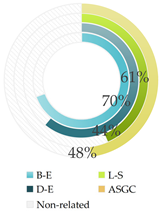 | 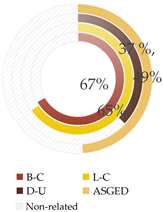 |
ASGC and ASGED

3.3. Strategy Analysis in SRSs Regarding Life Cycle Assessment
3.4. Carbon Emission Calculation Methods
4. Discussion
4.1. Summary and Analysis of Strategies
4.1.1. Prerequisites and Frequency of Strategies
4.1.2. Comprehensive Analysis of Strategies in 7 Dimensions
4.2. Recommendations for Enhancing the Application of LCCE Method in the Chinese Context
- (1)
- accelerate the development of local LCCE databases tailored for universities and develop unified life cycle tools to facilitate LCCE calculations;
- (2)
- establish optimization guidelines for LCCE and increase the weight of building life cycle performance assessment in rating systems to encourage comprehensive assessments;
- (3)
- establish an information collection platform for life cycle assessments of colleges and universities to accumulate reliable sample data, develop specific data entry and processing processes and regularly update statistical data.
5. Conclusions
- (1)
- Within the framework of seven dimensions encompassing planning and design, low-carbon transport, energy, resource utilization, building construction, energy management and carbon emission calculation, a total of 52 corresponding low-carbon design strategies were identified from BREEAM, LEED, DGNB and ASGA/ASGED across building and urban scales. These strategies serve as design references for higher education parks and provide a basis for standardization.
- (2)
- Analysis of strategy consistency across building and urban scales revealed the need for mutual supplementation and comprehensive consideration within the Planning and construction (1), Transport (2), Resource utilization (4) and Low-carbon building (5) dimensions. Through sorting the ratio of specific strategies to all carbon emission-related strategies, as well as analyzing the frequency of strategy occurrence and the strategies corresponding to prerequisites, we have identified strategies with higher attention across seven dimensions. Moreover, by amalgamating the frequency of strategy occurrences, a comprehensive analysis of strategies within each dimension is conducted. During the overall planning of the campus, the prioritization of low-carbon strategies is primarily contemplated at the city level, while separate buildings necessitate more attention at the building level. While the score share can indicate the degree of attention to a strategy, the scoring mechanism is influenced by various factors. Therefore, in actual circumstances, the consideration of key strategies must weigh factors such as economic viability, technological feasibility and other pertinent elements in a comprehensive manner.
- (3)
- All SRSs exhibit the highest level of concern for carbon reduction in operational energy, followed by materials production and recycling stages. Conversely, the construction and transport stages have the lowest percentage of scores. Strengthening the mandatory requirement for LCCE calculation in China is essential for designing carbon reduction strategies across all life cycle stages.
- (4)
- Early intervention in LCCE during the predesign stage encourages designers to adopt an LCA perspective in their design thinking. Establishing a benchmarking system at both national macro and unit levels can offer a more objective and comprehensive evaluation of building life cycle carbon emissions.
Author Contributions
Funding
Data Availability Statement
Acknowledgments
Conflicts of Interest
Appendix A
| BREEAM | LEED | DGNB | ASGC | |
|---|---|---|---|---|
| Building level | Education | For school | Education | Secondary vocational schools and colleges and universities |
| Scope | Education includes: Universities and specialized colleges, including: a. Teaching facilities; b. Learning resource centers; c. Laboratories, seminar rooms or studios; d. Student activity buildings; e. A mixture of the above types of buildings | Schools may optionally be used for higher education and non-academic buildings on school campuses | All educational buildings, including: The primary use of these buildings is rooms for education, training, seminars, lectures, workshops and classrooms. Secondary uses in the building being assessed, such as offices, kitchen, refectory, laboratory, library, gym, etc., are assessed within the same scope | Green campuses should be evaluated as individual campuses or schools as a whole |
| Source | BREEAM International New Construction Technical Manual 2016 | LEED v4 Building design and construction | DGNB system criteria set: new construction building 2020 | Assessment Standard of Green Campus 2019 (GB/T51356-2019): 3.1 basic requirements |
| Categories covered in this paper | Management (Man) Health and wellbeing (Hea) Energy (Ene) Transport (Tra) Water (Wat) Materials (Mat) Waste (Was) Land use and ecology (LE) Pollution (Pol) | Location and Transportation (LT) Sustainable Sites (SS) Water Efficiency Energy and Atmosphere (EA) Materials and Resources (MR) Indoor Environmental Quality (IE) | Environmental quality (ENV) Economic quality (ECO) Sociocultural and functional quality (SOC) Technical quality (TEC) Process quality (PRO) Site quality (SITE) | 5.1 Planning and Ecology 5.2 Energy and Resources 5.3 Environment and Health 5.4 Operation and Management |
| Urban scale | Communities | Cities and Communities | Districts Criteria Set | Assessment Standard of Green Eco-District |
| Scope | It can be applied to moderate or large mixed-use developments. And the assessment methodology may also deliver significant benefits for smaller-scale developments | It can be applied to non-city areas, such as counties, regions, districts, economic zones, neighborhoods, campuses and military installations. Large educational, institutional or industrial campuses and communities | The system is based on the schemes for urban districts (City), business districts (Business), event areas (Event), industrial sites (Industry) and commercial areas (Commercial) | The evaluation of green eco-cities should be pushed by the urban area, and the planning land area should be clarified |
| source | BREEAM Communities Technical Manual SD202 1.2-2012: Scope of BREEAM Communities | LEED v4.1 Cities and communities: plan and design communities | DGNB System criteria set: criteria set districts version 2020 | Assessment Standard for Green Eco-District (GB/T 51255-2017): 3.1 basic requirements |
| Category covered in this paper | Governance (GO) Social and economic wellbeing (SE) Resources and energy (RE) Land use and ecology (LE) Transport and movement (TM) | Integrative Process (IP) Natural System and Ecology (NS) Transportation and Land Use (WE) Energy and Greenhouse Gas Emissions (EN) Materials and Resource (MR) Quality of Life (QL) | Environmental quality (ENV) Economic quality (ECO) Sociocultural and functional quality (SOC) Technical quality (TEC) Process quality (PRO) | 4 Land Utilization 5 Ecological Environment 6 Green Building 7 Resource and Carbon Emission 8 Green Transportation 9 Informatization Management 12 Technical Innovation |
Appendix B
| Engineer Number | Title | Qualification | Field | Low Carbon Building Research and Practice Time/Years | Experience |
|---|---|---|---|---|---|
| A | Professor-level Senior Architect | LEED AP /BREEAM AP/Class I Certified Architects | Architecture | 21 | Over 100 green building scheme designs, over 100 design consultations and 20 green building standards |
| B | Professor-level Senior Engineer | LEED AP/ Certified Structural Engineers | Civil Engineering | 20 | Over 100 green building scheme designs, over 100 design consultations and 20 green building standards |
| C | Professor-level Senior Engineer | LEED AP/WELL AP/Certified Utility Engineers | HVAC | 18 | Over 100 green building scheme designs, over 100 design consultations and 20 green building standards |
| D | Professor-level Senior Engineer | LEED AP/ Class I Certified Architects | Architecture | 16 | 85 green building scheme designs, 35 design consultations and 8 green building standards |
| E | Senior Engineer | BREEAM AP/Certified Electrical Engineers | Electrical Engineering | 15 | 82 green building scheme designs, 31 design consultations and 6 green building standards |
| F | Senior Engineer | LEED AP/BREEAM AP/Certified Structural Engineers | Civil Engineering | 16 | 75 green building scheme designs, 12 design consultations and 6 green building standards |
| G | Senior Engineer | LEED AP/ Class I Certified Architects | Architecture | 15 | 80 green building scheme designs, 17 design consultations and 7 green building standards |
| H | Senior Engineer | LEED AP/ Class I Certified Architects | Architecture | 15 | 83 green building scheme designs, 25 design consultations and 6 green building standards |
| I | Professor-level Senior Architect | LEED AP/BREEAM AP | D&G Engineering | 19 | 76 green building scheme designs, 27 design consultations and 5 green building standards |
| J | Senior Engineer | LEED AP/ Certified Utility Engineers | HVAC | 14 | 65 green building scheme designs, 33 design consultations and 5 green building standards |
Appendix C
| Research | 1 | 2 | 3 | 4 | 5 | 6 | 7 | 8 | 9 | 10 | 11 | 12 | 13 | 14 |
|---|---|---|---|---|---|---|---|---|---|---|---|---|---|---|
| [9] | √ | √ | √ | √ | √ | √ | √ | √ | √ | |||||
| [16] | √ | √ | √ | √ | √ | √ | √ | √ | ||||||
| [29] | √ | √ | √ | √ | ||||||||||
| [30] | √ | |||||||||||||
| [31] | √ | √ | √ | √ | √ | √ | √ | √ | ||||||
| [32] | √ | √ | √ | √ | ||||||||||
| [33] | √ | √ | √ | √ | √ | √ | √ | √ | ||||||
| [34] | √ | √ | √ | √ | √ | √ | √ | |||||||
| [35] | √ | √ | √ | √ | √ | √ | √ | √ | √ | |||||
| [56] | √ | √ | √ | √ | √ | √ | ||||||||
| [57] | √ | √ | √ | √ | √ | √ | √ | |||||||
| [58] | √ | √ | √ | √ | √ | √ | √ | √ | √ | |||||
| [59] | √ | √ | √ | √ | √ | √ | √ | √ | √ | |||||
| [60] | √ | √ | √ | √ | √ | |||||||||
| [61] | √ | √ | √ | √ | √ | √ | ||||||||
| [62] | √ | √ | √ | √ | √ | √ | ||||||||
| [63] | √ | √ | √ | √ | ||||||||||
| [64] | √ | √ | √ | √ | ||||||||||
| [65] | √ | √ | √ | √ | √ | √ | √ | |||||||
| [66] | √ | √ | √ | √ | √ | |||||||||
| [67] | √ | √ | √ | √ | √ | √ | √ | √ | √ | √ |
Appendix D
| Coding | Dimension | Coding | Strategy |
|---|---|---|---|
| 1 | Planning and construction | 1.1 | Reasonable greening rate |
| 1.2 | The heat island effect reduction | ||
| 1.3 | Low-carbon construction | ||
| 1.4 | Achieving the carbon emission targets | ||
| 1.5 | Resilience planning | ||
| 1.6 | Reasonable building density and layout | ||
| 1.7 | Rational road network design | ||
| 1.8 | Microclimate regulation | ||
| 1.9 | Enhancement of green building compliance rate | ||
| 1.10 | Establishment of shared spaces and facilities | ||
| 1.11 | Ecological analysis | ||
| 1.12 | Measures for ecological protection of the site | ||
| 2 | Low-carbon transport | 2.1 | Bike-ability |
| 2.2 | Walk-ability | ||
| 2.3 | Charging electric vehicle devices | ||
| 2.4 | Accessibility of public transport | ||
| 2.5 | Vehicle sharing | ||
| 2.6 | Rationalization of parking spaces | ||
| 2.7 | Parking spaces rationalized | ||
| 2.8 | Frequency of public transport | ||
| 3 | Energy | 3.1 | Fulfillment of high requirements for energy-efficient design |
| 3.2 | Overall energy connectivity enhancement | ||
| 3.3 | Energy efficiency of equipment improvement | ||
| 3.4 | Enhancement of energy efficiency | ||
| 3.5 | Renewable energy utilization | ||
| 3.6 | Clean energy utilization | ||
| 3.7 | Grid harmonization | ||
| 3.8 | Flexibility and expansion reserves of the building | ||
| 3.9 | Real-time energy monitoring | ||
| 4 | Resource utilization | 4.1 | Material durability improvement |
| 4.2 | Low-carbon, recyclable materials utilization | ||
| 4.3 | Material recycling | ||
| 4.4 | Full utilization of existing buildings and facilities | ||
| 4.5 | Wastewater recycling and reuse | ||
| 4.6 | Enhanced refrigerant management | ||
| 4.7 | Efficient utilization of water resources | ||
| 4.8 | Waste management | ||
| 4.9 | Rainwater harvesting and utilization | ||
| 4.10 | Control of NOx emissions | ||
| 5 | Low-carbon building | 5.1 | Passive strategies of buildings |
| 5.2 | Indoor light environment optimization | ||
| 5.3 | Indoor wind environment optimization | ||
| 5.4 | Accessibility of building components for cleaning | ||
| 5.5 | Enhancement of the heat transfer performance of the building envelope | ||
| 5.6 | Indoor thermal comfort optimization | ||
| 5.7 | Building space efficiency | ||
| 6 | Management | 6.1 | Establishment of low-carbon energy management platform |
| 6.2 | Low-carbon target setting | ||
| 6.3 | Establishment of a management mechanism for carbon emission reduction | ||
| 7 | Carbon emissions calculation | 7.1 | Life cycle performance assessment in the design stage |
| 7.2 | Optimization for reducing life cycle carbon emissions | ||
| 7.3 | Comparison with carbon emission baseline values | ||
| 7.4 | Control of greenhouse gas emissions per capita |
References
- Caifei, W. Member Wang Yanxin: Promoting the Construction of Carbon-Neutral Campuses in Colleges and Universities. Available online: https://www.cas.cn/zt/hyzt/2022lh/jjkj/202203/t20220304_4827055.shtml (accessed on 12 October 2023).
- Yuan, X.; Zuo, J.; Huisingh, D. Green Universities in China–what matters? J. Clean. Prod. 2013, 61, 36–45. [Google Scholar] [CrossRef]
- Hollberg, A.; Ruth, J. LCA in architectural design—A parametric approach. Int. J. Life Cycle Assess. 2016, 21, 943–960. [Google Scholar] [CrossRef]
- Meex, E.; Hollberg, A.; Knapen, E.; Hildebrand, L.; Verbeeck, G. Requirements for applying LCA-based environmental impact assessment tools in the early stages of building design. Build. Environ. 2018, 133, 228–236. [Google Scholar] [CrossRef]
- Li, Q.; Yang, W.; Kohler, N.; Yang, L.; Li, J.; Sun, Z.; Yu, H.; Liu, L.; Ren, J. A BIM–LCA Approach for the Whole Design Process of Green Buildings in the Chinese Context. Sustainability 2023, 15, 3629. [Google Scholar] [CrossRef]
- Yu, H.; Yang, W.; Li, Q.; Li, J. Optimizing Buildings’ Life Cycle Performance While Allowing Diversity in the Early Design Stage. Sustainability 2022, 14, 8316. [Google Scholar] [CrossRef]
- Office, T.A.S. Major Event in Tingshua. Available online: https://2021.tsinghua.edu.cn/dsj.htm (accessed on 21 April 2023).
- Findler, F.; Schönherr, N.; Lozano, R.; Stacherl, B. Assessing the Impacts of Higher Education Institutions on Sustainable Development—An Analysis of Tools and Indicators. Sustainability 2018, 11, 59. [Google Scholar] [CrossRef]
- GB/T51356-2019; Assessment Standard for Green Campus. National Standard of the People’s Republic of China: Beijing, China, 2019.
- T/CABEE 053-2023; Guideline for Carbon Emissions Accounting of University Campuses. China Association of Building Energy Efficiency (CABEE): Beijing, China, 2023.
- He, B.J.; Zhao, D.X.; Gou, Z. Integration of Low-Carbon Eco-City, Green Campus and Green Building in China. In Greening Energy and Technology; Springer: Berlin/Heidelberg, Germany, 2020; pp. 49–78. [Google Scholar] [CrossRef]
- Ministry of Education. National Statistical Bulletin on the Development of Education, 2022; Ministry of Education: Beijing, China, 2023. [Google Scholar]
- Ning, L. A Study of Influence of Collegiate Parks to Urban Development in China; East China Normal University: Shanghai, China, 2013. [Google Scholar]
- Technical Committee ISO/TC 207; Environmental Management—Life Cycle Assessment: Principles and Framework. International Organization for Standardization: Geneva, Switzerland, 2006.
- GB/T 51366-2019; Standard for Building Carbon Emission Calculation. National Standard of the People’s Republic of China: Beijing, China, 2019.
- Li, Y.; Gu, Y.; Liu, C. Prioritising performance indicators for sustainable construction and development of university campuses using an integrated assessment approach. J. Clean. Prod. 2018, 202, 959–968. [Google Scholar] [CrossRef]
- Karatzoglou, B. An in-depth literature review of the evolving roles and contributions of universities to Education for Sustainable Development. J. Clean. Prod. 2013, 49, 44–53. [Google Scholar] [CrossRef]
- Albareda-Tiana, S.; Vidal-Raméntol, S.; Fernández-Morilla, M. Implementing the sustainable development goals at University level. Int. J. Sustain. High. Educ. 2018, 19, 473–497. [Google Scholar] [CrossRef]
- Pacheco-Blanco, B.; Bastante-Ceca, M.J. Green public procurement as an initiative for sustainable consumption. An exploratory study of Spanish public universities. J. Clean. Prod. 2016, 133, 648–656. [Google Scholar] [CrossRef]
- Marinho, M.; Gonçalves, M.d.S.; Kiperstok, A. Water conservation as a tool to support sustainable practices in a Brazilian public university. J. Clean. Prod. 2014, 62, 98–106. [Google Scholar] [CrossRef]
- Yoshida, Y.; Shimoda, Y.; Ohashi, T. Strategies for a sustainable campus in Osaka University. Energy Build. 2017, 147, 1–8. [Google Scholar] [CrossRef]
- Mendoza, J.M.F.; Gallego-Schmid, A.; Azapagic, A. A methodological framework for the implementation of circular economy thinking in higher education institutions: Towards sustainable campus management. J. Clean. Prod. 2019, 226, 831–844. [Google Scholar] [CrossRef]
- Berzosa, A.; Bernaldo, M.O.; Fernández-Sanchez, G. Sustainability assessment tools for higher education: An empirical comparative analysis. J. Clean. Prod. 2017, 161, 812–820. [Google Scholar] [CrossRef]
- Cho, H.M.; Yun, B.Y.; Yang, S.; Wi, S.; Chang, S.J.; Kim, S. Optimal energy retrofit plan for conservation and sustainable use of historic campus building: Case of cultural property building. Appl. Energy 2020, 275, 115313. [Google Scholar] [CrossRef]
- Karuchit, S.; Puttipiriyangkul, W.; Karuchit, T. Carbon Footprint Reduction from Energy-Saving Measure and Green Area of Suranaree University of Technology, Thailand. Int. J. Environ. Sci. Dev. 2020, 11, 170–174. [Google Scholar] [CrossRef]
- Cai, P. Study on the Design of Campus Landscape Sketches under the Characteristics of Lingnan Regional Culture. Environ. Resour. Ecol. J. 2022, 6, 110–118. [Google Scholar] [CrossRef]
- Dai, J.; Jiang, S.; Li, J.; Xu, X.; Wu, M. The influence of layout on energy performance of university building. In IOP Conference Series: Earth and Environmental Science; IOP Publishing: Bristol, UK, 2019; p. 022069. [Google Scholar] [CrossRef]
- da Silva, L.A.; Dutra, A.R.d.A.; Soares, T.C.; Birch, R.S.; Guerra, J.B.S.O.d.A. Trends in research: Carbon footprint reduction in universities as a way to achieve a green campus. Int. J. Sustain. High. Educ. 2022, 24, 584–601. [Google Scholar] [CrossRef]
- Amaral, A.R.; Rodrigues, E.; Gaspar, A.R.; Gomes, Á. Lessons from unsuccessful energy and buildings sustainability actions in university campus operations. J. Clean. Prod. 2021, 297, 126665. [Google Scholar] [CrossRef]
- Leon, I.; Oregi, X.; Marieta, C. Environmental assessment of four Basque University campuses using the NEST tool. Sustain. Cities Soc. 2018, 42, 396–406. [Google Scholar] [CrossRef]
- Dawodu, A.; Guo, C.; Zou, T.; Osebor, F.; Tang, J.; Liu, C.; Wu, C.; Oladejo, J. Developing an integrated participatory methodology framework for campus sustainability assessment tools (CSAT): A case study of asino-foreign university in China. Prog. Plan. 2023, 183, 100827. [Google Scholar] [CrossRef]
- Dawodu, A.; Dai, H.; Zou, T.; Zhou, H.; Lian, W.; Oladejo, J.; Osebor, F. Campus sustainability research: Indicators and dimensions to consider for the design and assessment of a sustainable campus. Heliyon 2022, 8, e11864. [Google Scholar] [CrossRef] [PubMed]
- Jiang, Q.; Kurnitski, J. Performance based core sustainability metrics for university campuses developing towards climate neutrality: A robust PICSOU framework. Sustain. Cities Soc. 2023, 97, 104723. [Google Scholar] [CrossRef]
- Stars Technical Manual. Version 2.1. Available online: https://stars.aashe.org/pages/about/technical-manual.html (accessed on 28 May 2024).
- UI Green City Metric Methodology. Available online: https://greenmetric.ui.ac.id/about/methodology (accessed on 28 May 2024).
- Greening Universities Toolkit V2.0. Available online: https://www.unenvironment.org/resources/toolkits-manuals-andguides/greening-universities-toolkit-v20 (accessed on 28 May 2024).
- BREEAM. BREEAM Certification from BRE. Available online: https://bregroup.com/products/breeam/ (accessed on 20 March 2024).
- LEED Rating System: The Most Widely Used Green Building Rating System. Available online: https://www.usgbc.org/leed (accessed on 20 March 2024).
- Council, G.S.B. DGNB Certification. Available online: https://www.dgnb-system.de/en/ (accessed on 20 March 2024).
- C.E.N. Sustainability of Construction Works. Assessment of Environmental Performance of Buildings. Calculation Method; CEN: Brussels, Belgium, 2011. [Google Scholar]
- BRE. BREEAM Communities. Available online: https://breeam.com/standards/communities (accessed on 20 March 2024).
- U.S. German Sustainable Building Council. LEED for Cities and Communities. Available online: https://www.usgbc.org/leed/rating-systems/leed-for-cities-communities (accessed on 20 March 2024).
- U.S. German Sustainable Building Council. DGNB System for Ditrict. Available online: https://www.dgnb.de/en/certification/districts#:~:text=For%20certification%20according%20to%20the%20DGNB%20System%20for,publicly%20accessible%20spaces%20and%20corresponding%20infrastructure.%20...%20%E6%9B%B4%E5%A4%9A%E9%A1%B9%E7%9B%AE (accessed on 25 March 2024).
- GB/T 51255-2017; Assessment Standard for Green Eco-District. National Standard of the People’s Republic of China: Beijing, China, 2017.
- Yuan, G. Studies on the China’s Green Building Assessment System Integrated Assessment of Carbon Emissions; Tianjin University: Tianjin, China, 2015. [Google Scholar]
- GB/TGB/T51356-2019; Green Building Evaluation Standard. National Standard of the People’s Republic of China: Beijing, China, 2019.
- Santos, R.; Costa, A.A.; Silvestre, J.D.; Pyl, L. Integration of LCA and LCC analysis within a BIM-based environment. Autom. Constr. 2019, 103, 127–149. [Google Scholar] [CrossRef]
- Hollberg, A.; Genova, G.; Habert, G. Evaluation of BIM-based LCA results for building design. Autom. Constr. 2020, 109, 102972. [Google Scholar] [CrossRef]
- Cavalliere, C.; Habert, G.; Dell’Osso, G.R.; Hollberg, A. Continuous BIM-based assessment of embodied environmental impacts throughout the design process. J. Clean. Prod. 2019, 211, 941–952. [Google Scholar] [CrossRef]
- Ganassali, S.; Lavagn, M.; Campioli, A. LCA benchmarks in building’s environmental certiication system. In Proceedings of the Sustainability and Innovation for the Future, Albufeira, Algarve, Portugal, 13–16 September 2016. [Google Scholar]
- Melton, P. DOE to Test Grid-Harmonization Tech in the Real World. Available online: https://www.buildinggreen.com/newsbrief/doe-test-grid-harmonization-tech-real-world (accessed on 10 June 2024).
- Feist, W. Life-cycle energy analysis: Low-energy house, passive house, self-sufficient house. Int. Symp. CIB 1997, 1, 183–190. [Google Scholar]
- Li, Q.; Yang, W. Methodology of Life Cycle GWP Benchmarking for Buildings—Taking a Primary School in the Cold Climate Zone for Example. Urban Eviron. Des. 2023, 144, 54–58. [Google Scholar]
- GB 55015-2021; Standard Forlighting Design of Buildings. National Standard of the People’s Republic of China: Beijing, China, 2021.
- GB/T xxxxx–202x; Technical Standard for Zero Carbon Buildings (Draft for Soliciting Opinions). Beijing, China, 2023.
- G.R.I. GRI Initiative. Available online: https://www.globalreporting.org/ (accessed on 3 June 2024).
- Alshuwaikhat, H.M.a.A. An integrated approach to achieving campus sustainability: Assessment of the current campus environmental management practices. J. Clean. Prod. 2008, 16, 1777–1785. [Google Scholar] [CrossRef]
- T/QDSF 012-2022; Evaluation Guide for Low-Carbon Parks. Qingdao Modern Service Industry Federation: Qingdao, China, 2022.
- DB11/T 1552—2018; Beijing Municipal Commission of Planning and Natural Resources. Assessment Standard for Green Ecological Demonstration Region Planning: Beijing, China, 2019.
- The Green Plan Is Not Just Green. Available online: https://www.developpement-durable.gouv (accessed on 1 June 2024).
- Parvez, N.; Agrawal, A. Assessment of sustainable development in technical higher education institutes of India. J. Clean. Prod. 2019, 214, 975–994. [Google Scholar] [CrossRef]
- Wang, Y.L.; Zhang, T.; Yuan, B.; Li, S. Comprehensive Evaluation Indicators and Methods of Near-zero Carbon Emission Parks. Electr. Power Sci. Eng. 2023, 39, 51–60. [Google Scholar] [CrossRef]
- Zhenyu, H. Optimization for Planning and Design of Nanjing Zidong Low Carbon Park Guided by Evaluation System. Morden City Res. 2011, 5, 44–48, 66. [Google Scholar]
- Suzhou Zhongzi Engineering Consulting Co., Ltd. Research on the Construction Path of Near Zero Carbon Industrial Park in Suzhou Industrial Park; Energy Foundation: Beijing, China, 2023. [Google Scholar]
- Ding, Q.; Qian, J. Study on Green Campus Evaluation System under the Framework of Overall Sustainable Development of Campus—Taking University of California at Berkeley as an Example. Urban Build. 2014, 1, 50–58. [Google Scholar]
- Wu, E. Research on the Strategy of Green Campus Planning and Construction in Universities under the Background of “Dual Carbon”. Art Time 2023, 10, 68–70. [Google Scholar]
- Du, Y. The Green Campus Assessment System of Higher Education Institutions Based on Problem Aligning with Goal Orientation—Take the Beijing-Tianjin-Hebei as an Example; Tianjin University: Tianjin, China, 2021. [Google Scholar]
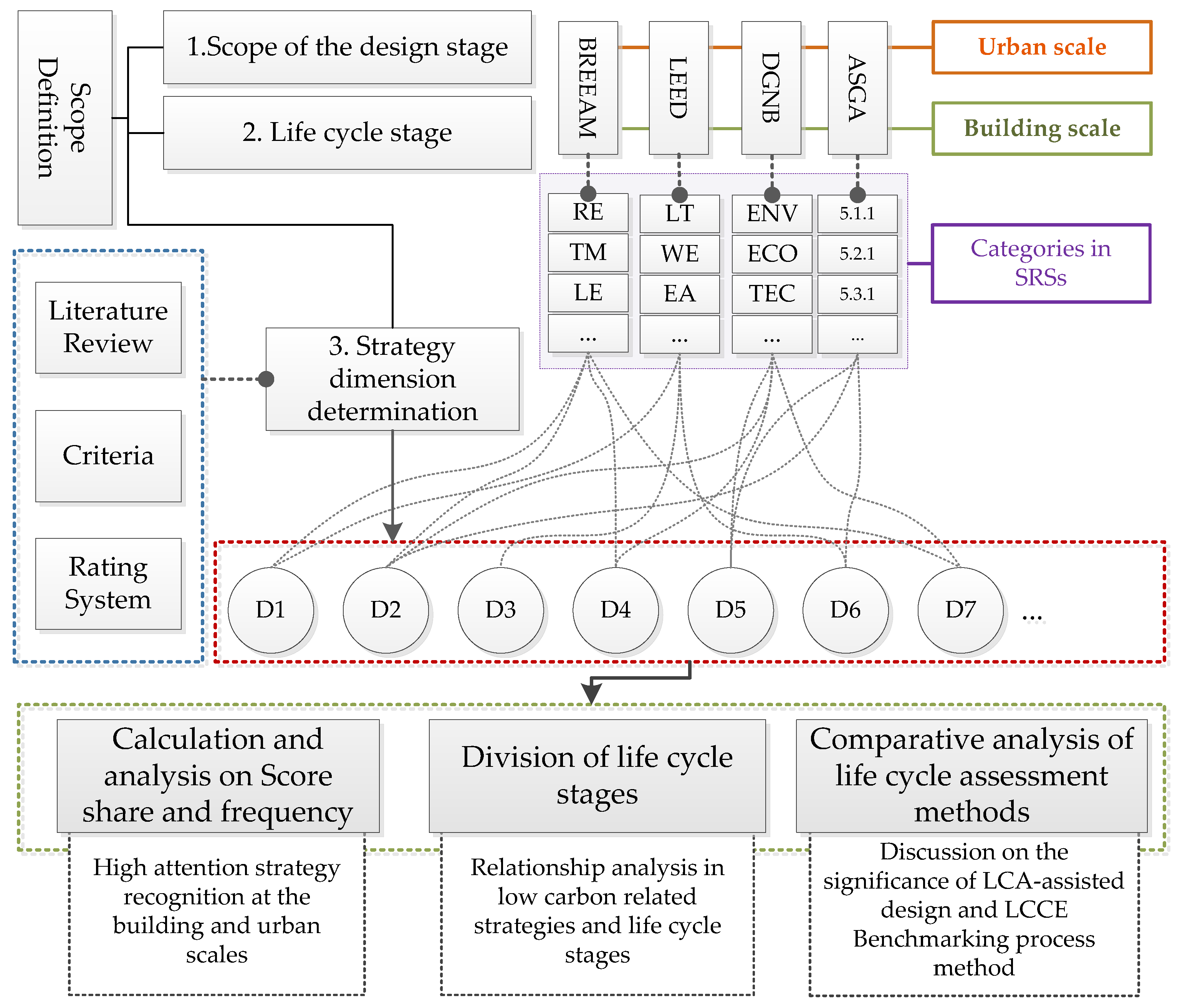

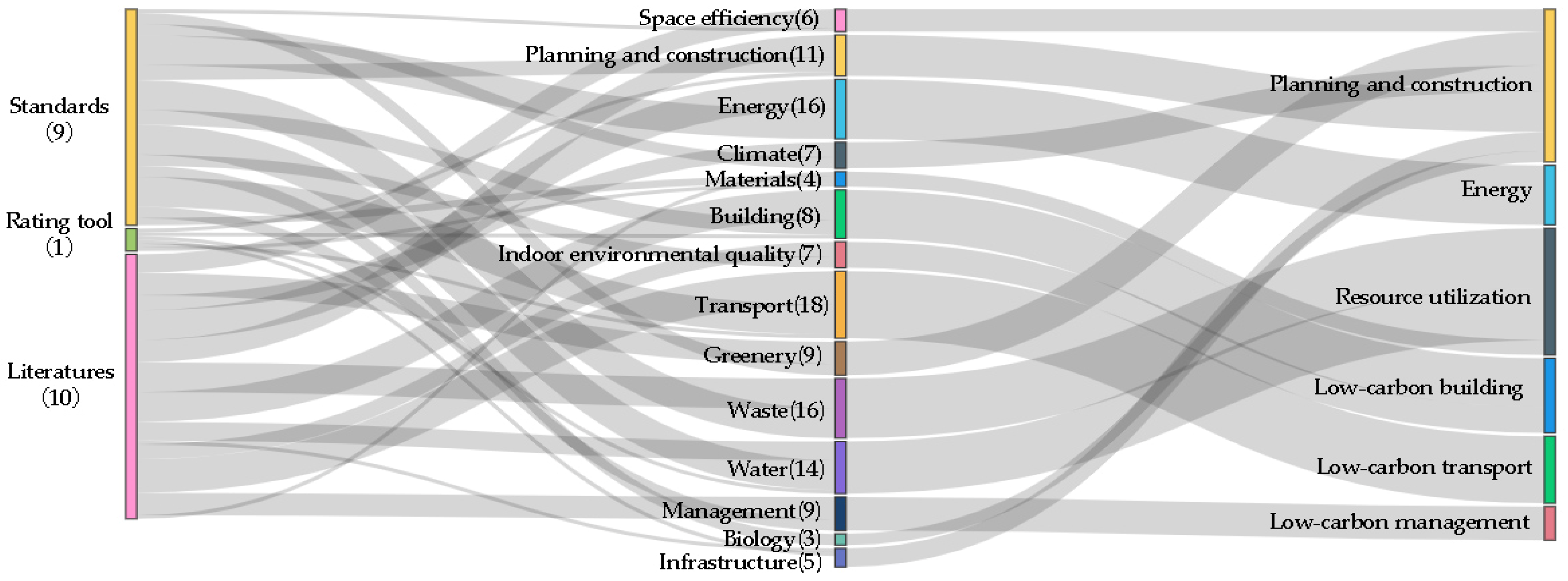

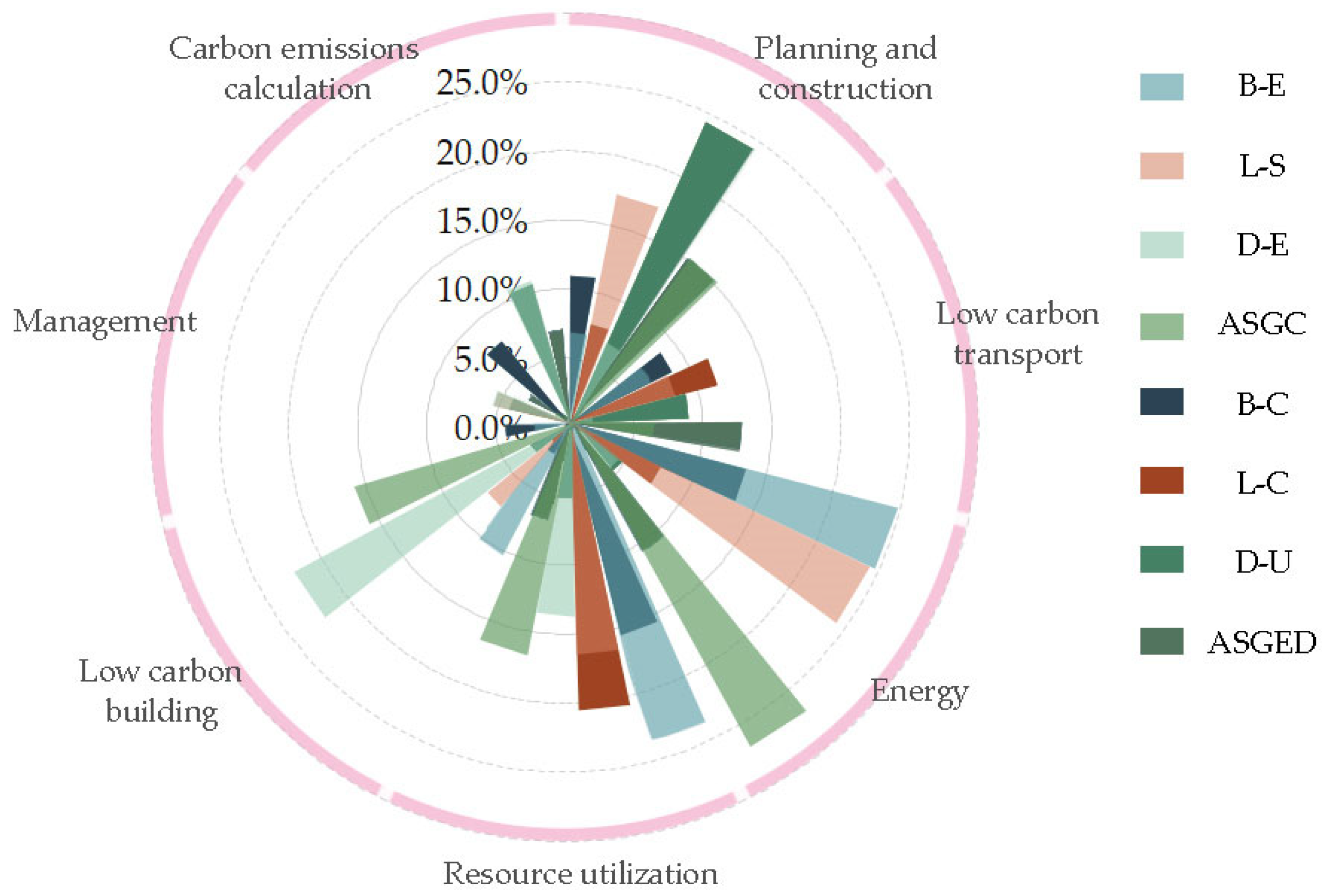


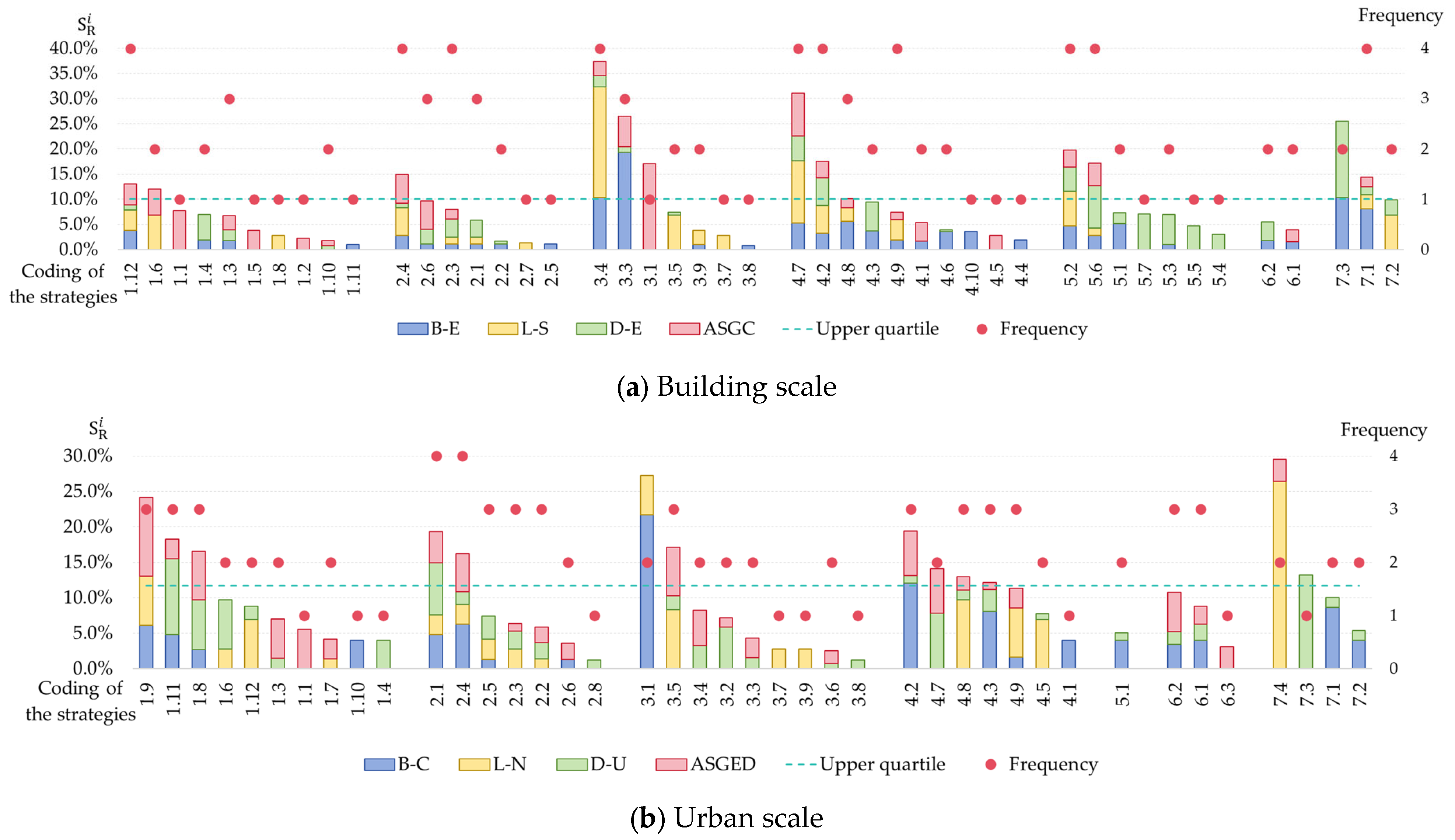
| MP | MT | C | RR | O | WU | DD | RE | |
|---|---|---|---|---|---|---|---|---|
| B-E | 15.7% | 9.5% | 14.3% | 9.5% | 43.6% | 8.4% | 9.0% | 13.2% |
| L-C | 10.9% | 8.2% | 1.8% | 11.8% | 36.4% | 13.6% | 11.8% | 10.0% |
| DGNB | 20.7% | 16.0% | 19.5% | 20.7% | 33.3% | 13.0% | 13.7% | 15.7% |
| ASGC | 7.7% | 1.8% | 4.8% | 5.9% | 31.8% | 10.9% | 2.6% | 4.8% |
| B-C | 20.7% | 15.3% | 15.3% | 18.0% | 46.7% | 7.9% | 18.0% | 18.0% |
| L-C | 6.4% | 4.5% | 4.5% | 6.4% | 44.5% | 15.5% | 12.7% | 10.9% |
| D-U | 7.8% | 7.4% | 8.6% | 7.8% | 33.1% | 10.6% | 9.1% | 7.4% |
| ASGED | 13.6% | 10.9% | 15.2% | 13.7% | 38.9% | 10.0% | 14.5% | 14.0% |
| B-E | L-S | D-E | ASGC | ||
|---|---|---|---|---|---|
| Share of LCA-related component scores | Energy–carbon emissions measurement | 7.2% | - | - | 1.67% |
| LCA | 5.6% | 6.4% | 8.6% | - | |
| Evaluation approaches and tools | Assessment methods | Normalized indicators (Ecopoint) | Optimization Comparison | Grading | Optimization comparison |
| Tools for LCA calculations | ByggLCA, Conpact, One Click LCA, eTool, Green Guide, COCON, ELODIE, MRPI Freetool MPG, nova EQUER, SBS Building Sustainability, Anavitor/ ECO2 | Athema Impact Estimator (North America), Envest2 (UK), LCA Design (Australia) SimaPro, GaBi | eLCA, LayLCA, LEGEP | T20-CE V7.0, PKPM-CES, Swell CEEB, East Harvest, Carbon Central Harvest AIA | |
| Database support | IMPACT | GaBi, SimaPro | Oekobau.dat, BRUSACO, CHISUCO, EUSUCO, UKRASUCO, EPD programs | China Carbon Emission Factor Database | |
| Benchmarking process approach | Benchmark approach | External benchmarks (building materials) Internal benchmarks (energy consumption) | Internal benchmarks | External benchmarks | Internal benchmarks (energy consumption) |
| Reference value setting | Ecopoint average value | Baseline building | Excess of target value General target value reference point threshold value | Baseline building (energy consumption) | |
| Source of baseline data | Statistics on certified buildings (building materials) Targeted programs (energy consumption) | Targeted programs | Statistics on certified buildings | Targeted programs (energy consumption) |
| BREEAM | LEED | DGNB | ASGC/ASGED | ||
|---|---|---|---|---|---|
| Building Scale | Operation Carbon | RE 01 | EN Prerequisite EN Credit: Grid Harmonization | ENV1.1 | 6.2.11 |
| RE 07 | |||||
| TM01 | |||||
| Embodied Carbon | RE 02 | EN Prerequisite | - | ||
| Urban Scale | Operation Carbon | RE01 | EN Prerequisite | ENV1.1 | 7.1.3 |
| TM07 | 7.2.14 | ||||
| Embodied Carbon | RE05 | - | - |
| 1 | 2 | 3 | 4 | 5 | 6 | 7 | |
|---|---|---|---|---|---|---|---|
| BREEAM | 1.11 | 2.7 | 3.5 | 4.3, 4.6, 4.7 | 5.2 | - | 7.1 |
| LEED | 1.1, 1.5, 1.11 | - | 3.3 | 4.3, 4.7 | 5.5 | - | |
| DGNB | 1.2 | - | 4.1 | 5.5 | - | 7.1 | |
| ASGC/ESGED | 1.6, 1.11 | 2.2 | 3.3 | 4.7 | 5.5 | 6.1, 6.2 | 7.3 |
Disclaimer/Publisher’s Note: The statements, opinions and data contained in all publications are solely those of the individual author(s) and contributor(s) and not of MDPI and/or the editor(s). MDPI and/or the editor(s) disclaim responsibility for any injury to people or property resulting from any ideas, methods, instructions or products referred to in the content. |
© 2024 by the authors. Licensee MDPI, Basel, Switzerland. This article is an open access article distributed under the terms and conditions of the Creative Commons Attribution (CC BY) license (https://creativecommons.org/licenses/by/4.0/).
Share and Cite
Li, Q.; Zeng, Y.; Meng, Y.; Kong, W.; Pei, Z. A Comparative Analysis of Low-Carbon Design Strategies for China’s Higher Education Parks Based on Building and Urban Scale in Sustainability Rating Systems. Buildings 2024, 14, 1846. https://doi.org/10.3390/buildings14061846
Li Q, Zeng Y, Meng Y, Kong W, Pei Z. A Comparative Analysis of Low-Carbon Design Strategies for China’s Higher Education Parks Based on Building and Urban Scale in Sustainability Rating Systems. Buildings. 2024; 14(6):1846. https://doi.org/10.3390/buildings14061846
Chicago/Turabian StyleLi, Qiyuan, Yu Zeng, Yuanyue Meng, Weici Kong, and Zhichao Pei. 2024. "A Comparative Analysis of Low-Carbon Design Strategies for China’s Higher Education Parks Based on Building and Urban Scale in Sustainability Rating Systems" Buildings 14, no. 6: 1846. https://doi.org/10.3390/buildings14061846






